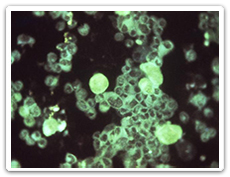Cytomegalovirus (CMV)
 Cytomegalovirus (CMV) is a member of the herpes virus family and subfamily Betaherpesvirinae. CMV is the most common cause of congenital infection. These are infections that happen at or before birth. There are three forms of CMV infection: (1) congenital infection, (2) neonatal infection and (3) infection in immunocompromised people. Although CMV infection rarely causes illness, when it does, in some cases, there can be serious complications.
Cytomegalovirus (CMV) is a member of the herpes virus family and subfamily Betaherpesvirinae. CMV is the most common cause of congenital infection. These are infections that happen at or before birth. There are three forms of CMV infection: (1) congenital infection, (2) neonatal infection and (3) infection in immunocompromised people. Although CMV infection rarely causes illness, when it does, in some cases, there can be serious complications.
Symptoms
CMV infection in healthy people is common. In most cases, it causes no obvious symptoms. But people with weakened immune systems and newborns may show symptoms. There are three forms of CMV infection, which can lead to different symptoms:
- Congenital Infection: Most infected infants appear healthy. A large majority may never have symptoms or disabilities. If symptoms do occur, they do so two or more years after birth. They may include low birth weight, yellowing of the skin, inflammation of lung tissue, anemia, eye infection and possible developmental disabilities.
- Neonatal Infection: Perinatally infected infants do not usually appear to have any disease unless they are premature or immunocompromised. Infection in premature infants can result in swollen liver and various blood disorders. Many may die or become severely ill.
- Infection in immunocompromised people: Symptoms can include fever, muscle pain, general feeling of ill health, joint pain, inflamed and swollen liver, and various blood disorders.
Causes
Infected people can shed CMV through their bodily fluids. Young children can shed the virus for months once they are infected. It is possible for them to spread the virus to their parents through shedding, although it is uncommon. There are different ways to acquire the infection:
- Blood of a pregnant woman with primary infection crossing the placenta and infecting her baby;
- Drinking of mother's milk;
- Direct contact with infectious tissues and fluids (for example, urine, saliva, and others);
- Inhaling respiratory droplets among nursery or day care center workers;
- Sex;
- Blood transfusions;
- Organ transplantation.
Treatment
Antiviral drug treatments are available.
Prevention
CMV infection can be prevented by practicing good hand hygiene. Do not share personal items like toothbrush that may have infectious tissues or fluids on them. Clean surfaces that come into contact with these tissues and fluids.
Other Resources
- Centers for Disease Control and Prevention – Cytomegalovirus (CMV) and Congenital CMV Infection
- Public Health Agency of Canada – CYTOMEGALOVIRUS
Communicable Disease
Control (CDC) Health Links – Info Santé |


